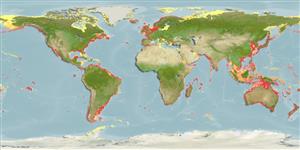Common names from other countries
Environment: milieu / climate zone / depth range / distribution range
Ecologie
; diepteverspreiding 0 - 80 m (Ref. 1603). Tropical; 68°N - 76°S, 180°W - 180°E
Circumglobal.
Length at first maturity / Size / Gewicht / Leeftijd
Maturity: Lm ? range ? - ? cm Max length : 0.1 cm TL mannelijk/geslacht niet bekend; (Ref. 2226)
Assumed maximum length of zooids from Ref. 2226. Found also on dead corals. Attached to hard substrata (Ref. 1603); from low water level (Ref. 226) to depth of about 80 m (Ref. 1603); occurs in mangrove ponds (Ref. 1758). Colonial (Ref. 415).
Life cycle and mating behavior
Geslachtsrijpheid | Voortplanting | Kuitschieten | Eieren | Fecundity | Larven
Members of the class Ascidiacea are hermaphroditic; both cross- and self-fertilization is typical. Life cycle: Eggs develop into lecithotrophic larva before metamorphosing into benthic adults.
Sanamyan, K. and D. Schories. 2004. (Ref. 3379)
Status op de Rode Lijst van het IUCN (Ref. 130435)
Status bij CITES (Ref. 108899)
Not Evaluated
Not Evaluated
Gebruik door de mens
| FishSource |
Tools
Meer informatie
Leeftijd/GrootteGroeiLengte-gewicht parametersLengte-lengte parametersMorfologieLarvenAbundantie
Internet-bronnen
Estimates based on models
Preferred temperature
(Ref.
115969): 7.3 - 27.9, mean 18.3 (based on 3200 cells).
Kwetsbaarheid
Low vulnerability (10 of 100).
Prijsklasse
Unknown.
